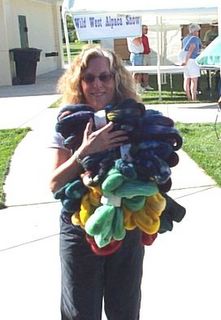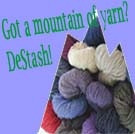Interchangeable Yarns and Amounts Needed
Yesterday, I was coaching Jade on her knitting (she is the second person in a week that I have taught to purl). She asked how to know how much yarn to buy, and it got me thinking about some resources for her and other people with this dilemma. Seems like most people are making scarves for their first several projects, and actually, that has been a recommended first project in just about forever, but now the yarns are prettier and have more textures to choose from. It is pretty easy to find a chunky-weight yarn that you like, and equally easy to find a starting pattern. The Lion Yarn website has a cool chart that shows their yarns and several types of projects - scarf and hat, socks, baby blanket, vest, sweater - with approximate skeins to buy in each of their yarns. That is a pretty good indicator, but what if the yarn you want isn't a Lion yarn, and is different than the yarn listed?
If you already can tell the difference in yarn weights (they range from extra-chunky through chunky, bulky, worsted, DK, sport and fingering), then you can use the yardage listed on the wrapper for the yarn given in the pattern, figure out the total yards needed, then get the same yardage in a yarn of the same weight group. It is really handy that more and more manufacturers are giving the yardage on the product label, as well as suggested needle size, which helps you figure out which category. This is also the case with magazines such as Knitters, Vogue Knitting and Interweave Knits. Keep in mind that the weight category refers to the yarn knitting up to approximately the same gauge, but it might not give you the same look and feel as the original choice. That's where asking an expert comes in handy, whether a fellow knitter or a pro at your LYS (local yarn shop).
Get yourself on the Patternworks catalog list, and start reading it, as they do the best job I have seen of sorting out yarns by weight group, and they provide the yardage information for each item in their catalog
. Paper is still better than virtual sometimes, because you can flip back and forth and compare and look at the larger color pictures, but sometimes the best thing is to go in to your LYS and ask for help in coming up with a substitution. Most dealers keep interchangeable yarn charts on hand to show what would make a good substitution. They will also have seen some of the yarns to let you know if the "hand" (feel and drape) is going to be the same. I haven't been able to locate an interchangeable chart on the web yet, but will keep looking and post it. I relied heavily on such charts when I was younger, as I couldn't afford the high-priced fancy stuff.
For the past twenty years, I have lived too remotely for LYS help, and have done a lot of mail order, so I needed to know at least what general category and make substitutions based on what is available. Patterns written with very specific yarns in mind often become outdated, in that the yarns listed, especially if they are "fancy" or seasonal introductions, often go out of stock. There are others like them on the market, if you know what the original yarn was like. New yarn is being introduced all the time, and you will want to be able to include something you happen upon into your work successfully.
Learn as much as you can about fiber content and how the different fibers feel and work up, so that you can match the yarn you select with the item you plan to make... socks need to be made out of a hardier yarn than a shawl, for example. That is why it is so great to see a resurgence of LYS's in towns throughout the country; they are there to provide you with tactile stimulation and experience! Go to the public events so that you can see what other people are making, and so you can touch the yarns. This is one of the best parts of being a knitter.
If you already can tell the difference in yarn weights (they range from extra-chunky through chunky, bulky, worsted, DK, sport and fingering), then you can use the yardage listed on the wrapper for the yarn given in the pattern, figure out the total yards needed, then get the same yardage in a yarn of the same weight group. It is really handy that more and more manufacturers are giving the yardage on the product label, as well as suggested needle size, which helps you figure out which category. This is also the case with magazines such as Knitters, Vogue Knitting and Interweave Knits. Keep in mind that the weight category refers to the yarn knitting up to approximately the same gauge, but it might not give you the same look and feel as the original choice. That's where asking an expert comes in handy, whether a fellow knitter or a pro at your LYS (local yarn shop).
Get yourself on the Patternworks catalog list, and start reading it, as they do the best job I have seen of sorting out yarns by weight group, and they provide the yardage information for each item in their catalog
. Paper is still better than virtual sometimes, because you can flip back and forth and compare and look at the larger color pictures, but sometimes the best thing is to go in to your LYS and ask for help in coming up with a substitution. Most dealers keep interchangeable yarn charts on hand to show what would make a good substitution. They will also have seen some of the yarns to let you know if the "hand" (feel and drape) is going to be the same. I haven't been able to locate an interchangeable chart on the web yet, but will keep looking and post it. I relied heavily on such charts when I was younger, as I couldn't afford the high-priced fancy stuff.
For the past twenty years, I have lived too remotely for LYS help, and have done a lot of mail order, so I needed to know at least what general category and make substitutions based on what is available. Patterns written with very specific yarns in mind often become outdated, in that the yarns listed, especially if they are "fancy" or seasonal introductions, often go out of stock. There are others like them on the market, if you know what the original yarn was like. New yarn is being introduced all the time, and you will want to be able to include something you happen upon into your work successfully.
Learn as much as you can about fiber content and how the different fibers feel and work up, so that you can match the yarn you select with the item you plan to make... socks need to be made out of a hardier yarn than a shawl, for example. That is why it is so great to see a resurgence of LYS's in towns throughout the country; they are there to provide you with tactile stimulation and experience! Go to the public events so that you can see what other people are making, and so you can touch the yarns. This is one of the best parts of being a knitter.













0 Comments:
Post a Comment
<< Home